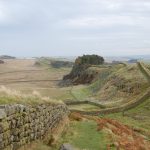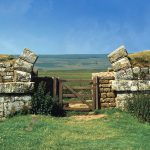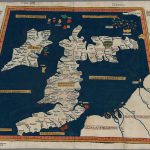Iping Settlement
Mansio
Iping is the site of a probable Roman mansio – consisting of bank, ditch and slight counter-scarp bank. It has rounded corners.
Iping W. Sussex. Epinges 1086 ( DB ). ‘(Settlement of) the family or followers of a man called *Ipa’. OE pers. name + -ingas.” (Mills)
This rectangular earthwork with rounded corners lies astride the Roman road between two major British tribal centres at Noviomagus Regnorum (Chichester) and Venta Belgarum (Winchester). Measuring a mere 282 feet by 367 (86 x 112 metres), the area enclosed by the turf defences was only about 2¼ acres (c.0.9ha), which is very small indeed, and would have difficulty accommodating more than the official posting station and perhaps an iron-smithy. The station is situated just over two miles to the north of Iping village, just south-east of the point where the Roman road crossed the Hammer Stream. Although unexcavated, surface finds of Roman material have been found within the confines of the earthwork by the Ordnance Survey.
Care should be taken when locating the Iping station on the OS Landranger Map #197 (Chichester & the Downs) even though it is clearly marked, as the titchy (86×112 metres) earthwork is situated – at National Grid Reference SU:844261 – over two miles north of the crossing of the Rother in Iping village, and could easily be confused with the Hammer Wood Iron-Age contour fort which lies much closer to the modern settlement.
The Iping Roman Station lies a little over half a mile from the crossroads in the centre of the village of Milland, so the reason why this archaeological site is assigned to Iping, over two miles away on the opposite side of the Rother is a complete mystery.
Similar Stations in South Britain
The Roman posting-station at Iping is comparable in both size and form to Hardham and Alfoldean on Stane Street. It is possible that Iping is contemporary with these other two enclosures, which have both been excavated and dated to the mid-first century; these then, are among the earliest Roman posting-stations in Britain. Unlike the larger stations at Mancetter, Water-Eaton, Ancaster, Leintwardine and elsewhere, which had their ramparts reinforced with a masonry frontage in the third century, the early turf defences of all three of these smaller stations were not refurbished.
The Hammer Wood Contour Fort
The Hammer Wood fort lies on a natural south-facing scarp above the Hammer Stream about ¾mile north of its confluence with the Rother (at NGR SU:846240), and measures some 400 x 220 metres, which at almost 22 acres would have been big enough to house nearly half a legion, a fact that would surely have warranted a mention in at least one of the classical geographies. This apparent discrepancy is explained in Barry Cunliffe’s Iron-Age Communities in Britain, which states that the Hammer Wood camp is a ‘contour fort’, attributed to the Iron-Age Wealden culture.
The identification of this Iron-Age fort with the Iping Roman station is confused by the fort’s rectangular plan, which although resembling the regular Roman pattern, merely follows the local topography of the scarp above the river Rother. It must be conceded that the site may have be used in late-Roman times, but probably only as a refuge against Saxon attacks on the south coast.
References for Iping
- Historical Map and Guide – Roman Britain by the Ordnance Survey (3rd, 4th & 5th eds., 1956, 1994 & 2001);
- Oxford Dictionary of English Place-Names by A.D. Mills (Oxford 1998);
- Roadside Settlements in Lowland Roman Britain by Roger Finch Smith (B.A.R. British Series #157, 1987) p.279;
- Iron Age Communities in Britain by Barry Cunliffe (London, 1974).
Roman Roads near Iping
NNW (11) to Neatham S (13) to Noviomagvs Regnorvm (Chichester, West Sussex)
Sites near Iping Settlement
- Stroud Villa (12 km)
Temple Or Shrine and Villa - Butser Ancient Farm (16 km)
Museum - Bignor Roman Villa (18 km)
Villa - Neatham (Vindomis) Roman Settlement (18 km)
Antonine Posting Station and Minor Settlement - Hardham Roman Settlement (21 km)
Mansio and Minor Settlement - Fishbourne Roman Palace (Villa Regis Cogidubni) (21 km)
Supply Depot and Villa - Chichester (Noviomagus Reginorum) (21 km)
British Capital and Port - Bosham Harbour (Magnus Portus) (22 km)
Port - Compton Villa (25 km)
Villa - Hayling Island Temple (26 km)
Temple Or Shrine








